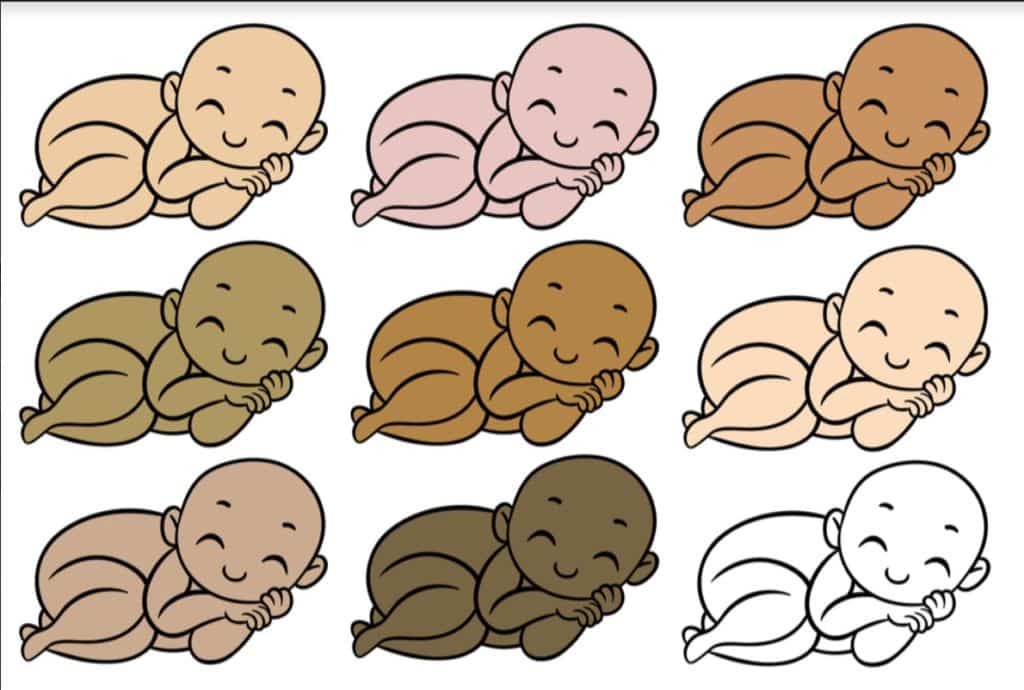As your due date gets closer, you’re excited about finally meeting that bundle of joy you have been nursing through pregnancy. Of course, at this point, there’s always a lot of excitement as well as a thousand questions running through your mind. One of which is definitely how to determine your baby skin color.
Furthermore, many women also ask: How big will my baby be? What will my baby look like? How beautiful will my baby’s smile be? As we mentioned earlier, another common question that runs through the mind of expecting parents is one regarding the skin color of their baby. As expected, many parents give utmost priority and importance to their baby’s complexion.

It is worthy to note that the appearance of a baby’s skin will differ based on factors like ethnicity or race, age, temperature, genetics, environment, and whether there’s a medical condition.
This post gives you an insight into the various skin colors that a baby may have, the explanations behind each skin color as well as what’s considered abnormal. Keep on following.
Table of Contents:
What’s the Normal Baby Skin Color at Birth?
Newborns may have a variety of skin colors at birth.
Generally, regardless of race or ethnicity, a normal baby will maintain a skin tone of reddish-purple at birth. This is because the circulatory system is just getting to work and blood reaches major internal organs first rather than the extremities. Typically, this skin tone resolves after about 4 hours of life.
Sometimes, a yellow skin tone may be typical when a baby is born but yellow skin can also be a sign of jaundice, a medical condition common in children. The yellow tone is expected to fade over the next few days (between 14-28 days) if it is not because of any underlying condition.
You can read this article to learn all you need to know about jaundice.

Likewise, a baby may be born with hands and feet that have a bluish tone (cyanosis). The bluish tone is because the circulatory system is yet to develop fully so there is reduced blood flow to their hands and feet. This normally fades over the next few days. If the blue tint persists, then it may be a sign of underlying conditions which include a syndrome known as “blue baby syndrome”, tetralogy of Fallot, Tricuspid atresia, and total anomalous pulmonary venous return (TAPVR).
How does my baby’s skin color change over time?
The color your baby’s skin appears to be at birth is not a permanent skin color.
Over the months, your baby’s complexion may keep evolving until a certain age when a permanent skin color sticks. Depending on the ethnicity or some other environmental factors, your baby’s skin color may become darker or lighter as the years go by.
This brings the question, when do I know my baby’s true skin color?
The truth is there’s no definite answer to that question. A number of factors come into play to determine your baby’s true color. However, typically, by the 6th month of life, your baby’s true skin tone should have started developing.

If you have concerns about your baby’s skin color, you should speak to your healthcare provider about your concerns.
What determines a baby’s skin color?
A child’s complexion is controlled predominantly by genes inherited from parents. The trait responsible for skin color in children is a polygenic trait. This means that the trait depends on more than one gene.
Normally, a child receives half of its genetic makeup from each of its parents. The combination of dominant genes from each of the parents will determine the baby’s skin color eventually.
However, genetics can sometimes be complex. There are some genes that are involved in skin color that can be skipped in generations. This means that your baby might not end up looking like you or your partner.
Not to worry, this is normal. It’s just genetics at play. You might also be surprised to find out that twins may not always have the same skin color. Experts have not been able to determine the exact way genes combine to give an actual baby skin color.
The pigment melanin is what determines skin tone and hair color. This pigment is passed from parents to children and is what determines if your child will be fair or dark.
Babies with a darker complexion simply have more melanin in their skin than fairer babies. The more melanin, the darker the skin. If your baby is dark, it is not something to worry about. It only means your baby produces more melanin and this has its upsides. Melanin protects the skin from UV rays from the sun.
How Can I Change My Baby’s Skin Color?
Sometimes, parents are tempted to lighten or darken their baby’s skin. This may be because of society’s prejudice against skin color.
Regardless of your baby’s skin tone, your baby is beautiful, and you should only take care of your baby’s skin appropriately. Your baby’s skin complexion is determined predominantly by genetics. You don’t have any control over it, and you can’t change the color. Trying to alter your baby’s skin color could lead to you damaging your baby’s sensitive skin.

The best thing you can do for your baby’s skin is to embrace the color and take care of that natural color. Don’t bother investing in products that promise to change your baby’s skin color. No beauty product will change your baby’s skin color. Rather, clean and maintain your baby’s God-given skin tone. All babies are beautiful!
Conclusion
Babies can have diverse skin colors when they are born. Usually, a baby reaches its permanent skin tone around 20 months old.
Genetics is what determines how a baby will look. As a result of the different ways genes combine, babies might look like one parent than the other or neither of the parents. This is normal. Regardless of your baby’s skin tone, your baby is beautiful, and no skin tone is inferior to another. Learn to embrace and cherish your baby’s skin. This way you can give it the proper care it needs.
You should also note that certain skin colors are normal for a newborn baby. If a particular skin color persists or you’re generally concerned about your baby’s skin color, speak to your healthcare provider.

